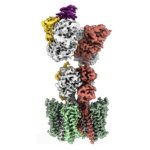About Us
The MRC Laboratory of Molecular Biology (LMB) is a research institute dedicated to the understanding of important biological processes at the levels of atoms, molecules, cells and organisms. In doing so, we provide knowledge needed to solve key problems in human health.
Our scientists tackle fundamental, often difficult and long-term research problems. The LMB has made revolutionary contributions to science, such as pioneering X-ray crystallography and electron cryo-microscopy (cryo-EM) to determine protein structures, the sequencing of DNA and the development of monoclonal antibodies. Twelve Nobel Prizes have been awarded for work carried out by LMB scientists.
The LMB also promotes the application and exploitation of our research findings, both by collaboration with existing companies and the founding of new ones, helping to advance medical research and the translation and application of knowledge.
The LMB provides an unsurpassed environment for both young and established researchers, with state-of-the-art facilities and a unique scientific culture. The LMB has always been very diverse, with a truly international outlook. We currently employ men and women from over 50 countries, and LMB alumni work in research organisations across the world.
Insight on Research
Distinct AMPA receptor sub-types reside within glial and neuronal cells of the cerebellum

Multidisciplinary study from Ingo Greger’s group in the LMB’s Neurobiology Division reveals the structures and subunit assembly of GluA4 AMPA receptors in the mammalian cerebellum that support cell-type specific functions.
Transplant of human chromosomes marks first step in genome synthesis project

Researchers in the LMB’s PNAC Division detail a new pipeline to implant human chromosomes into mouse cells and back again without genomic damage, marking an important step towards the overall goal of synthesising human genomes.
Quick Links
Latest News
 EMBO selects Ana Tufegdžić Vidaković to join Young Investigator Programme
EMBO selects Ana Tufegdžić Vidaković to join Young Investigator ProgrammeAna Tufegdžić Vidaković, Group Leader in the LMB’s PNAC Division, joins the global community of early-career researchers, with training, mentorship and networking opportunities from EMBO. […]
 Martin Kyte (1958 – 2025)
Martin Kyte (1958 – 2025)The LMB is deeply saddened to share that Martin Kyte, Senior Design Engineer in the Electronics Workshop, died suddenly in early November 2025. […]
Latest Publications
- Drosophila DNp03 descending neurons serve as a hub within a flight saccade network.
Croke, H., et al.
Curr Biol [Epub ahead of print]. (12th December 2025) - TMT-based quantitative proteomic assessment of Vicia sativa induced neurotoxicity by β-cyano-L-alanine and γ-glutamyl-β-cyano-L-alanine in SH-SY5Y cells.
Riley, S., et al.
Sci Rep [Epub ahead of print]. (11th December 2025) - Structure and organization of AMPA receptor-TARP complexes in the mammalian cerebellum.
Scrutton, AM., et al.
Science : eaeb3577 [Epub ahead of print]. (11th December 2025) - Paclitaxel compromises nuclear integrity in interphase through SUN2-mediated cytoskeletal coupling.
Hale, T., Hale, VL., Kolata, P., Dos Santos, Á., Allegretti, M.
J Cell Sci [Epub ahead of print]. (10th December 2025) - Mycobacteria trehalose dimycolate interactions with host Mincle remodel blood-brain barrier junctions for brain invasion.
Hayes, MI., Ravishankar, S., Shanahan, JK., Fountain, AJ., Ramakrishnan, L., Madigan, CA.
Cell Rep 44(12): 116661 [Epub ahead of print]. (10th December 2025) - Adjusting PSC culture for neural organoid generation.
Sutcliffe, MA., Jensen, P., Tan, J., Morris, CAJ., Fazakerley, DJ., Larsen, MR., Lancaster, MA.
Stem Cell Reports : 102724 [Epub ahead of print]. (4th December 2025) - High-fidelity human chromosome transfer and elimination.
Petris, G., et al.
Science 390(6777): 1038-1043. (4th December 2025)
See more Publications





